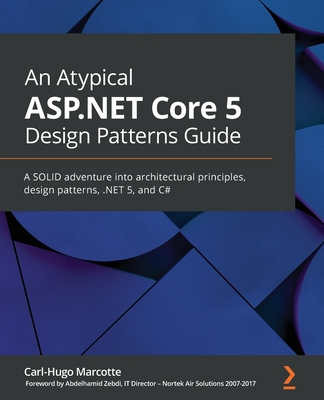Just Enough Software Architecture: A Risk-Driven Approach (Hardcover)
暫譯: 剛好足夠的軟體架構:風險驅動的方法 (精裝版)
George H. Fairbanks
- 出版商: Prentice Hall
- 出版日期: 2010-09-01
- 售價: $2,700
- 貴賓價: 9.5 折 $2,565
- 語言: 英文
- 頁數: 376
- 裝訂: Hardcover
- ISBN: 0984618104
- ISBN-13: 9780984618101
-
相關分類:
Design Pattern
-
相關翻譯:
恰如其分的軟件架構:風險驅動的設計方法 (簡中版)
立即出貨 (庫存=1)
買這商品的人也買了...
-
 溫伯格的軟體管理學-系統化思考 (第1卷) (Quality Software Management, Volume 1: Systems Thinking)
溫伯格的軟體管理學-系統化思考 (第1卷) (Quality Software Management, Volume 1: Systems Thinking)$650$514 -
 The Algorithm Design Manual, 2/e (Hardcover)
The Algorithm Design Manual, 2/e (Hardcover)$3,540$3,363 -
 圖解 HTTP
圖解 HTTP$359$341 -
 Visual C# 與 Xamarin 跨平台行動 App 開發實戰 ─ iOS/Android/Windows 一次搞定
Visual C# 與 Xamarin 跨平台行動 App 開發實戰 ─ iOS/Android/Windows 一次搞定$500$425 -
 It's Django -- 用 Python 迅速打造 Web 應用
It's Django -- 用 Python 迅速打造 Web 應用$400$340 -
 精通 Python|運用簡單的套件進行現代運算 (Introducing Python: Modern Computing in Simple Packages)
精通 Python|運用簡單的套件進行現代運算 (Introducing Python: Modern Computing in Simple Packages)$780$616 -
 完整學會 Git, GitHub, Git Server 的24堂課
完整學會 Git, GitHub, Git Server 的24堂課$360$284 -
 WordPress 架站的 12堂課|網域申請x架設x佈景主題x廣告申請
WordPress 架站的 12堂課|網域申請x架設x佈景主題x廣告申請$480$379 -
 最新 Java 8 程式語言, 4/e
最新 Java 8 程式語言, 4/e$650$553 -
 了解人工智慧的第一本書:機器人和人工智慧能否取代人類?
了解人工智慧的第一本書:機器人和人工智慧能否取代人類?$360$284 -
 Python 自動化的樂趣|搞定重複瑣碎 & 單調無聊的工作 (中文版) (Automate the Boring Stuff with Python: Practical Programming for Total Beginners)
Python 自動化的樂趣|搞定重複瑣碎 & 單調無聊的工作 (中文版) (Automate the Boring Stuff with Python: Practical Programming for Total Beginners)$500$425 -
 Android App 程式設計教本之無痛起步 -- 使用 Android Studio 2.X 開發環境
Android App 程式設計教本之無痛起步 -- 使用 Android Studio 2.X 開發環境$580$493 -
 學會 Python - 從不懂,到玩上手!
學會 Python - 從不懂,到玩上手!$550$468 -
 無瑕的程式碼-敏捷完整篇-物件導向原則、設計模式與 C# 實踐 (Agile principles, patterns, and practices in C#)
無瑕的程式碼-敏捷完整篇-物件導向原則、設計模式與 C# 實踐 (Agile principles, patterns, and practices in C#)$790$616 -
 TensorFlow + Keras 深度學習人工智慧實務應用
TensorFlow + Keras 深度學習人工智慧實務應用$590$460 -
 寫程式前就該懂的演算法 ─ 資料分析與程式設計人員必學的邏輯思考術 (Grokking Algorithms: An illustrated guide for programmers and other curious people)
寫程式前就該懂的演算法 ─ 資料分析與程式設計人員必學的邏輯思考術 (Grokking Algorithms: An illustrated guide for programmers and other curious people)$390$308 -
 善良者必懂的 49個暗黑賽局:明白「人性厚黑心理」,就能讓成功變得理所當然! (全新修訂版)
善良者必懂的 49個暗黑賽局:明白「人性厚黑心理」,就能讓成功變得理所當然! (全新修訂版)$280$238 -
 看板實戰 : 用一張便利貼訓練出100分高效率工作團隊 (Kanban in Action)
看板實戰 : 用一張便利貼訓練出100分高效率工作團隊 (Kanban in Action)$560$437 -
 鳳凰專案|看 IT部門如何讓公司從谷底翻身的傳奇故事
鳳凰專案|看 IT部門如何讓公司從谷底翻身的傳奇故事$480$379 -
 SQL Server 與 R 開發實戰講堂
SQL Server 與 R 開發實戰講堂$680$578 -
 單元測試的藝術, 2/e (The Art of Unit Testing: with examples in C#, 2/e)
單元測試的藝術, 2/e (The Art of Unit Testing: with examples in C#, 2/e)$650$507 -
 $354UML 基礎 案例與應用, 3/e (修訂版)
$354UML 基礎 案例與應用, 3/e (修訂版) -
 資安防禦指南|資訊安全架構實務典範 (Defensive Security Handbook: Best Practices for Securing Infrastructure)
資安防禦指南|資訊安全架構實務典範 (Defensive Security Handbook: Best Practices for Securing Infrastructure)$580$458 -
 Software Architecture in Practice, 4/e (Paperback)
Software Architecture in Practice, 4/e (Paperback)$2,280$2,166 -
 Node.js 量化投資全攻略:從資料收集到自動化交易系統建構實戰(iThome鐵人賽系列書)【軟精裝】
Node.js 量化投資全攻略:從資料收集到自動化交易系統建構實戰(iThome鐵人賽系列書)【軟精裝】$760$502
相關主題
商品描述
This is a practical guide for software developers, and different than other software architecture books. Here's why:
It teaches risk-driven architecting. There is no need for meticulous designs when risks are small, nor any excuse for sloppy designs when risks threaten your success. This book describes a way to do just enough architecture. It avoids the one-size-fits-all process tar pit with advice on how to tune your design effort based on the risks you face.
It democratizes architecture. This book seeks to make architecture relevant to all software developers. Developers need to understand how to use constraints as guiderails that ensure desired outcomes, and how seemingly small changes can affect a system's properties.
It cultivates declarative knowledge. There is a difference between being able to hit a ball and knowing why you are able to hit it, what psychologists refer to as procedural knowledge versus declarative knowledge. This book will make you more aware of what you have been doing and provide names for the concepts.
It emphasizes the engineering. This book focuses on the technical parts of software development and what developers do to ensure the system works not job titles or processes. It shows you how to build models and analyze architectures so that you can make principled design tradeoffs. It describes the techniques software designers use to reason about medium to large sized problems and points out where you can learn specialized techniques in more detail.
It provides practical advice. Software design decisions influence the architecture and vice versa. The approach in this book embraces drill-down/pop-up behavior by describing models that have various levels of abstraction, from architecture to data structure design.
商品描述(中文翻譯)
這是一本針對軟體開發者的實用指南,與其他軟體架構書籍有所不同。原因如下:
**它教導風險驅動的架構設計。** 當風險較小時,無需過於細緻的設計;而當風險威脅到你的成功時,則沒有任何理由可以為草率的設計辯護。本書描述了一種適度的架構設計方法。它避免了一刀切的過程陷阱,並提供如何根據面臨的風險調整設計工作的建議。
**它使架構民主化。** 本書旨在使架構與所有軟體開發者相關。開發者需要了解如何使用約束作為指導,確保達成預期的結果,以及看似微小的變更如何影響系統的屬性。
**它培養陳述性知識。** 能夠擊球與知道為什麼能夠擊球之間是有區別的,心理學家稱之為程序性知識與陳述性知識的區別。本書將使你更清楚自己所做的事情,並為這些概念提供名稱。
**它強調工程技術。** 本書專注於軟體開發的技術部分,以及開發者為確保系統正常運作所做的工作,而非職稱或流程。它展示了如何建立模型和分析架構,以便你能夠做出有原則的設計取捨。它描述了軟體設計師用來推理中到大型問題的技術,並指出你可以在哪裡更詳細地學習專門技術。
**它提供實用建議。** 軟體設計決策會影響架構,反之亦然。本書中的方法通過描述具有不同抽象層次的模型,從架構到資料結構設計,來擁抱深入/彈出行為。














